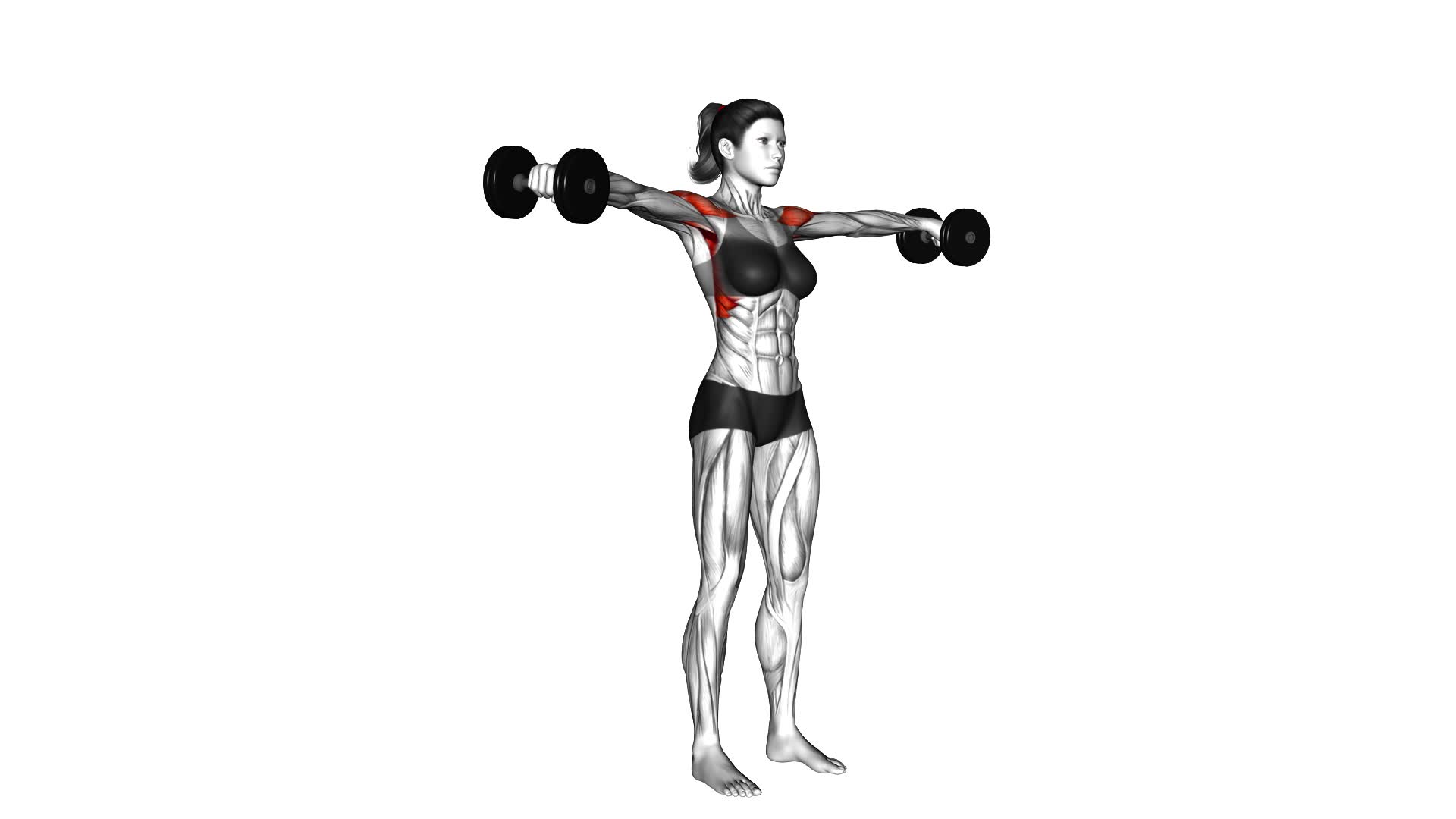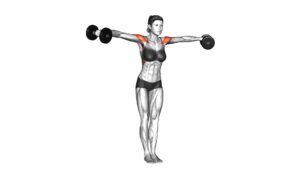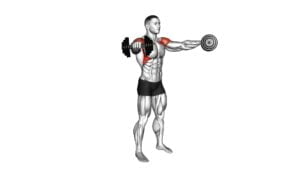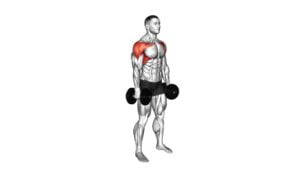Dumbbell Standing Lateral Raise (female) – Video Exercise Guide & Tips

Looking to tone your shoulders? Check out this video exercise guide for the dumbbell standing lateral raise!
Watch This Exercise Video
You'll learn proper form, tips for choosing the right weight, and variations to increase difficulty.
Avoid common mistakes and maximize shoulder activation with these expert tips.
Get ready to sculpt and strengthen those shoulder muscles!
Key Takeaways
- Stand with feet shoulder-width apart
- Hold a dumbbell in each hand
- Target the lateral deltoids
- Develop strong and defined shoulders
Proper Form for Dumbbell Standing Lateral Raise
To perform the Dumbbell Standing Lateral Raise correctly, start by standing with your feet shoulder-width apart and hold a dumbbell in each hand.
This exercise offers numerous benefits for your shoulders and upper body strength. The main benefit of the dumbbell standing lateral raise is that it targets the lateral deltoids, which are the muscles on the sides of your shoulders. By performing this exercise, you can develop strong and defined shoulders.
Additionally, it helps to improve shoulder stability, as you have to control the movement of the dumbbells throughout the exercise. Shoulder stability is crucial for daily activities and other exercises that involve the upper body. It helps to prevent injuries and enhances overall performance.
By incorporating the dumbbell standing lateral raise into your workout routine, you can improve your shoulder strength and stability, leading to better posture and a more balanced physique.
Now that you understand the importance of shoulder stability in this exercise, let's move on to the next section and discuss how to choose the right dumbbell weight for your workout.
Choosing the Right Dumbbell Weight
Now that you understand the benefits of the dumbbell standing lateral raise and the importance of shoulder stability, let's delve into choosing the right dumbbell weight for your workout. Here are three important factors to consider when selecting the appropriate weight:
- Comfort: Start with a weight that feels comfortable and allows you to perform the exercise with proper form. If the dumbbell is too heavy, you may compromise your technique and risk injury. On the other hand, if the weight is too light, you won't challenge your muscles enough for growth and improvement.
- Progression: As you become stronger and more comfortable with the exercise, it's important to progressively increase the weight to continue challenging your muscles. Gradually increase the weight by small increments to avoid straining your muscles or joints.
- Fatigue: The weight you choose should allow you to perform the desired number of repetitions with proper form, while still feeling a sense of fatigue towards the end of each set. If you're able to breeze through the exercise without feeling any fatigue, it may be time to increase the weight.
Variations to Increase Difficulty
As you progress in your dumbbell standing lateral raise, you can increase the difficulty with variations that target different areas of your shoulders. One way to do this is by implementing progressive overload, which involves gradually increasing the weight you lift over time. Start with a weight that challenges you but still allows you to maintain proper form. As you become stronger, gradually increase the weight to continue challenging your muscles and promoting growth.
Another variation to increase the difficulty of your standing lateral raise is by incorporating resistance bands. These bands provide additional resistance throughout the movement, intensifying the workout and targeting your shoulder muscles even more. Begin by attaching the resistance band to a stable object, such as a pole or a door handle. Hold onto the band with your hands while performing the lateral raise exercise. The resistance provided by the band will engage your muscles in a different way, making the exercise more challenging.
Common Mistakes to Avoid
To ensure proper form and maximize the effectiveness of your dumbbell standing lateral raise, it's important to be aware of common mistakes to avoid. Here are some common errors to watch out for:
- Using excessive weight: One of the most common mistakes people make is using weights that are too heavy. This not only compromises form but also increases the risk of injury. Start with lighter weights and gradually increase as your strength improves.
- Swinging the body: Another mistake is swinging the body to lift the dumbbells. This reduces the isolation of the shoulder muscles and transfers the workload to other muscles, such as the lower back. Keep your body stable and focus on lifting the weights with controlled movements.
- Lifting the dumbbells too high: It's important to lift the dumbbells to shoulder height, not above it. Lifting too high can put unnecessary strain on the shoulder joint and lead to injury. Focus on raising the dumbbells to a comfortable and controlled height.
By avoiding these common mistakes, you can perform the dumbbell standing lateral raise with proper form and maximize the activation of your shoulder muscles.
Now, let's move on to the next section and learn some tips for maximizing shoulder activation.
Tips for Maximizing Shoulder Activation
To maximize shoulder activation during the dumbbell standing lateral raise, use an appropriate weight that challenges you without compromising your form. This exercise is great for targeting the shoulder muscles and improving shoulder mobility. By properly activating your shoulders, you can enhance your overall upper body strength and stability.
One tip for maximizing shoulder activation is to focus on maintaining proper form throughout the exercise. Keep your back straight, core engaged, and shoulders relaxed. Avoid shrugging your shoulders or using momentum to lift the weights. Instead, lift the dumbbells in a controlled and deliberate manner, ensuring that your shoulder muscles are doing the work.
Another tip is to start with lighter weights and gradually increase the resistance as you become stronger and more comfortable with the exercise. This will help you avoid strain or injury and allow you to maintain proper form. Remember, it's better to use lighter weights with correct form than heavier weights with poor form.
Incorporating exercises for shoulder mobility, such as shoulder circles or arm swings, into your warm-up routine can also help improve shoulder activation during the dumbbell standing lateral raise. These exercises will help loosen up the shoulder joints and increase blood flow to the muscles, preparing them for the workout ahead.
Frequently Asked Questions
How Many Sets and Reps Should I Do for the Dumbbell Standing Lateral Raise?
To maximize your shoulder workout, it's important to know how many sets and reps you should do for the dumbbell standing lateral raise. This exercise targets your lateral deltoids and helps to build shoulder strength and definition.
To start, aim for 3-4 sets of 8-12 reps, using a weight that challenges you but allows you to maintain proper form. Remember to keep your core engaged and avoid swinging your body to get the weights up.
Can I Use a Resistance Band Instead of Dumbbells for This Exercise?
Yes, you can use a resistance band instead of dumbbells for the lateral raise exercise. Resistance bands offer a different type of resistance compared to dumbbells, which can help target your muscles in a unique way.
The benefits of using resistance bands for strength training include improved stability, increased muscle activation, and the ability to easily adjust the resistance level.
Experiment with both options to find what works best for you and your fitness goals.
Is It Necessary to Warm up Before Performing the Dumbbell Standing Lateral Raise?
Before performing the dumbbell standing lateral raise, it's absolutely necessary to warm up. A proper warm up is important because it prepares your muscles and joints for the exercise, reducing the risk of injury.
It also increases blood flow and oxygen to the muscles, improving their performance. Stretching before the lateral raise further enhances flexibility and range of motion.
Can This Exercise Be Modified for Individuals With Shoulder Injuries?
If you have a shoulder injury, modifications can be made to the dumbbell standing lateral raise exercise. Instead of using dumbbells, you can try using resistance bands or cables to reduce strain on your shoulders.
Another alternative exercise is the bent-over lateral raise, which targets the same muscles but with less stress on your shoulders.
Always consult with a healthcare professional or a qualified trainer to ensure you're performing exercises that are safe for your injury.
What Other Exercises Can I Incorporate Into My Workout Routine to Target the Same Muscle Group as the Dumbbell Standing Lateral Raise?
To target the same muscle group as the dumbbell standing lateral raise, there are several exercises you can incorporate into your workout routine.
Try the seated lateral raise, cable lateral raise, or bent-over lateral raise. These exercises engage the deltoids and help develop shoulder strength and stability.
For individuals with shoulder injuries, it's important to consult with a professional to determine the best variations and modifications that suit your specific needs and limitations.
Conclusion
In conclusion, the dumbbell standing lateral raise is a great exercise for targeting the shoulder muscles. By maintaining proper form, choosing the right weight, and incorporating variations, you can increase the difficulty and challenge your muscles even more.
Avoid common mistakes and follow the tips provided to maximize shoulder activation and get the most out of this exercise.
So grab your dumbbells and start raising those shoulders for a stronger, more defined upper body.

Author
Years ago, the spark of my life’s passion ignited in my mind the moment I stepped into the local gym for the first time. The inaugural bead of perspiration, the initial endeavor, the very first surge of endorphins, and a sense of pride that washed over me post-workout marked the beginning of my deep-seated interest in strength sports, fitness, and sports nutrition. This very curiosity blossomed rapidly into a profound fascination, propelling me to earn a Master’s degree in Physical Education from the Academy of Physical Education in Krakow, followed by a Sports Manager diploma from the Jagiellonian University. My journey of growth led me to gain more specialized qualifications, such as being a certified personal trainer with a focus on sports dietetics, a lifeguard, and an instructor for wellness and corrective gymnastics. Theoretical knowledge paired seamlessly with practical experience, reinforcing my belief that the transformation of individuals under my guidance was also a reflection of my personal growth. This belief holds true even today. Each day, I strive to push the boundaries and explore new realms. These realms gently elevate me to greater heights. The unique combination of passion for my field and the continuous quest for growth fuels my drive to break new ground.







